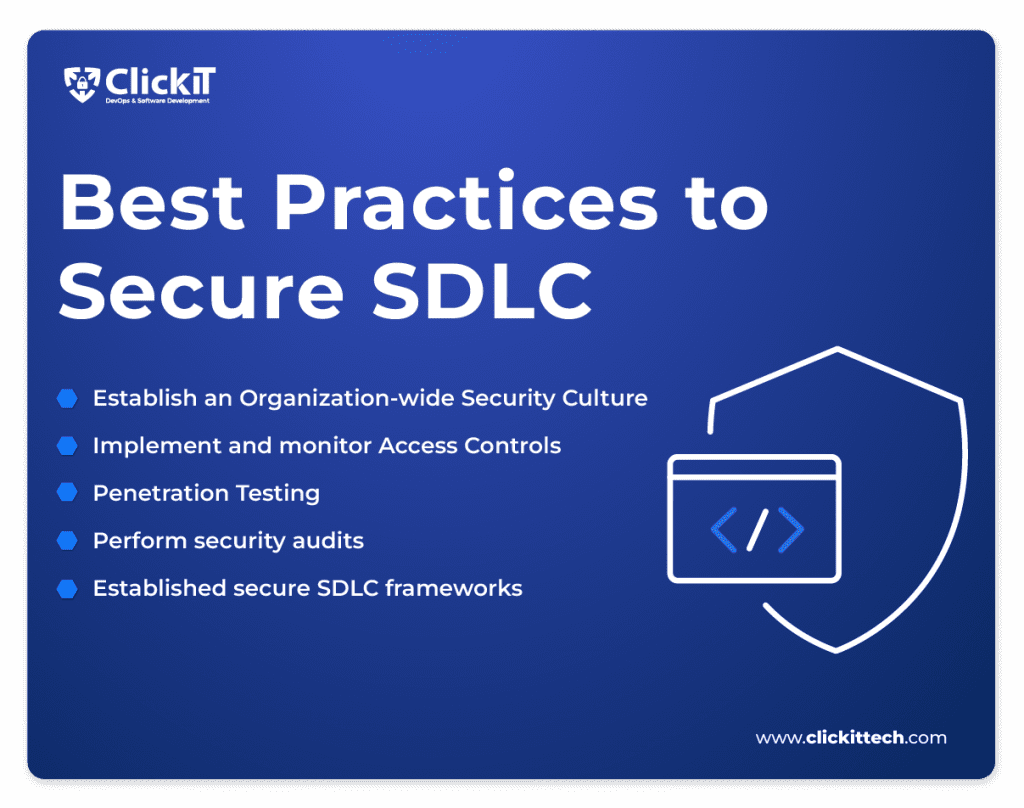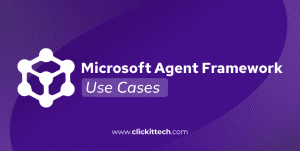A Secure SDLC is more important than ever. Gone are the days of releasing a product into the market and then fixing bugs in the next patches. Nowadays, attackers will exploit any weakness in your software application to steal sensitive data, thereby exposing you to financial and reputational damage that’s why you need security in SDLC.
The software development life cycle, or SDLC, is a framework that provides a structured process for software development. It describes the key stages a software application goes through, from planning to design, development, testing, deployment, and maintenance. This systematic approach ensures the software is developed in a way that meets user requirements and quality standards.
In this guide, we’ll explain the importance of security in SDLC, the necessary stages, best practices, and tools to help you achieve it.
- What is Secure SDLC?
- How Does a Secure SDLC Work?
- SDLC Security Best practices
- Secure SDLC Tools
- How ClickIT Helps Ensure Security in SDLC
- Conclusion
- FAQs
What is Secure SDLC?
Secure SDLC or SSDLC integrates security into the software development life cycle. It describes a set of processes and activities that you should follow to ensure that your software application is developed with security in mind. This means considering security concerns at every stage, ensuring you develop secure software free from vulnerabilities.
One of the biggest pain points we see in software development is leaving security until the last minute during testing. Unfortunately, this is too late. By this point, the code is pretty much set in stone because the design and development stages are complete.
This makes it more difficult and costly to address security vulnerabilities that could’ve been fished out from the get-go.Therefore, the goal of a secure SDLC is to proactively incorporate security considerations early on (and throughout) the development process. Rather than scrambling to patch holes later on, secure SDLC allows you to identify and mitigate potential security weaknesses and threats before they turn into a nightmare.

How Does a Secure SDLC Work?
According to a recent report in security magazine, 92% of companies experienced a breach last year due to vulnerabilities in the software applications developed in-house. This paints a dire picture of the importance of security in SDLC. It simply cannot be an afterthought!
The Shift-left security strategy, a core principle behind secure SDLC, emphasizes introducing security considerations early on. This not only improves release planning accuracy for your software development team but, more importantly, results in secure software.
Unfortunately, only 25% of companies have implemented this security strategy. Considering how vulnerabilities are growing rapidly, there’s no better time than now to start. If you’re stuck, let’s take a look at how security can become a necessary consideration in the software development life cycle:
Requirements Gathering and Planning
Every journey starts with a plan, and software development is no different. This fundamental stage of SDLC includes market and customer research, defining the project scope, resources, timelines, technologies (programming languages and frameworks), and budget. Essentially, you’re outlining the blueprint for your software application.
In the context of secure SDLC, you must also identify security requirements in this phase. That is, conducting risk assessments to find potential security threats and vulnerabilities in the software and mitigate them.
In this phase, you should consider answering questions like:
- What type of data will the software application store or process? This could be user passwords, credit card numbers, social security numbers, etc.
- Who will have access to the application and data?
- What are the current security vulnerabilities that similar software projects face?
- How can these security vulnerabilities be researched and tested?
- What could be the potential consequence of a security breach? This could be data loss, financial loss, or reputational damage.
By defining security requirements from the onset, you ensure all stakeholders understand what’s needed, and these considerations are included in the software design. Ultimately, this phase and answers to these questions can help you draw up a threat model to identify potential attack points and the appropriate controls to protect the software.
Design
With your security requirements in hand, you turn them into a practical, buildable solution in the design stage. That is, combining different tools and technologies to build the software application’s features that function well and prioritize user security.
Regardless of the individual preferences of stakeholders across the product and engineering teams, security requirements in this stage of the SDLC are still paramount.
This includes using secure design patterns, implementing the right controls, and conducting a thorough security review of the design.
Additionally, you may also build upon the initial threat modeling from the planning. This means considering the specific design choices made to identify possible vulnerabilities in the proposed architecture and data flows.
Coding
Now, it’s time to write the code. Secure SDLC requires that you follow secure coding practices to ensure security is embedded into every line of code. This includes tactics like:
- Sanitizing inputs correctly to clean and validate data from external sources before processing. This can help avoid malicious code injection.
- Following secure coding standards such as OWSAP Secure Coding Practices and SEI CERT Coding Standards. These provide guidelines for memory management, error handling, etc.
- Conducting regular code reviews, including those from external security specialists. Fresh eyes are always effective for catching coding mistakes that could become a security nightmare in the long run.
- Using static application security testing (SAST) tools to find likely bugs and vulnerabilities lurking within your code.
- Providing developer training in secure coding principles. A survey showed that 81% of developers applied the knowledge gained from training, which improved code security and reduced vulnerability.
- Mandating the principle of least privilege and default deny in access permissions. This ensures users (and code) have the minimum access necessary, and all actions are denied by default unless explicitly allowed.
- Conduct consistent software composition analysis (SCA) scans for open-source tools. This allows you to find outdated and vulnerable third-party dependencies within your codebase.
At ClickIT, our software development and DevOps managed services bridge the gap between development and operations. We optimize your teams’ collaboration, improve code quality through continuous integration, and expedite secure software delivery.
By partnering with ClickIT, you gain access to a proven methodology and skilled professionals dedicated to safeguarding your digital assets.

Testing
Security testing ensures the code works as intended and is also safe to use. In the traditional software development life cycle, security is usually pushed to the testing phase. However, testing becomes more straightforward because you’ve integrated security requirements into your SDLC until now, particularly through secure coding.
There’ll be fewer vulnerabilities to find, and it’ll be less expensive.
Testing within a secure SDLC encompasses a multi-layered approach:
- Developers conduct manual tests to uncover mistakes, bugs, defects, and other issues in the software application. These errors could affect the functionality, usability, performance, and, of course, security of the product.
- Regular security audits to protect sensitive business data.
- Conducting automated testing can speed up the process by automating repetitive and time-consuming manual testing tasks. This can help improve testing accuracy and efficiency.
- Using continuous integration tooling for ongoing tests as the software code changes or is merged into a larger codebase. This continuous feedback loop helps detect and fix defects early, improves better collaboration, and ensures faster release cycles.
- Performing penetration testing to simulate real-world attacks, helping you to find how vulnerable the underlying operating systems and network configurations are.
Although secure coding might have helped cut down on security vulnerabilities, some issues may be trickier to detect until the testing phase. For example, runtime vulnerabilities in your APIs that only manifest when they interact with specific cloud environments. You may also encounter misconfigurations in access controls and logic flaws within the code.
However, this comprehensive testing strategy further strengthens security in SDLC, helping you deliver a more secure and reliable software application.

Deployment
Even the process of deploying the software to become available to the users (and everything after) needs to be secure. A secure SDLC in the deployment phase ensures your software remains secure in production.
Here’s how to maintain security during deployment:
- Security assessment of the deployment environment: Before deploying your software, it’s important to conduct a thorough security assessment of the target environment (servers, networks, and databases). This helps you dig out potential vulnerabilities that could be exploited.
- Implement appropriate security controls: Based on the findings from your security assessments, implement the right security controls to mitigate identified risks. These controls might include:
- Network segmentation to isolate critical systems and data from less sensitive ones. Building separate clusters for production and non-production environments can help achieve this.
- Using GitOps Practices (for example, when using Kubernetes environment) to ensure changes made by users are tracked and approved before going into the final build.
- Automated deployments with rollback mechanisms: Streamlining deployments with automation tools while having a rollback plan in place minimizes risks and allows for quick recovery in case of issues.
- Strong authentication and authorization to ensure only authorized users can access the system and perform specific actions.
Maintenance
Additionally, security doesn’t stop after deployment. A product’s life cycle goes beyond its introduction into the market. It’s important to continuously maintain it to ensure it stays at peak market penetration for a long time. This process of maintenance also ensures it remains secure against new and emerging threats or changes to the cloud environment that could cause misconfigurations.
You can ensure secure SDLC during maintenance by:
- Applying security patches to the deployed software and underlying infrastructure to address newly found vulnerabilities. But even the process of updating software requires care. For example, the recent catastrophic CrowdStrike outage that crippled global systems and caused over $5 billion in losses shows the severe consequences that can come from botched software updates. This incident is a reminder that even established security solutions can be vulnerable if not maintained diligently.
- Using security monitoring tools and vulnerability scanners to detect suspicious activity and potential threats.
- Developing and regularly testing an incident response plan for a quick and effective response to breaches.
Following these practices will help extend the secure SDLC approach throughout all the required phases and beyond.
SDLC Security Best practices
As the software development landscape evolves, so do the threats we face. Now that we’ve locked in the steps to ensure secure SDLC, let us also discuss general security best practices to implement throughout your software development life cycle.

Establish an Organization-wide Security Culture
It’s important to imbibe the security culture into your team. That is, security is at the top of everyone’s mind in the organization, even non-technical stakeholders. Establishing this mindset fosters a culture of security awareness. You can achieve an organization-wide security culture through regular security training on coding best practices, new and evolving threats, potential risks, and security frameworks.
Another good idea is incident response planning and drills, which involve practicing how to respond to security incidents. This can help emphasize the importance of timely reporting and following established protocols. You may also want to incentivize security-conscious behavior. This could be recognizing and rewarding employees who complete security training, report vulnerabilities or go the extra mile to secure software applications and sensitive data.
Implement and monitor Access Controls
To ensure security in SDLC, always evaluate and strengthen your access permissions to keep the software supply chain secure. You can do this by implementing the principle of least privilege, where users are only granted access to the resources they need to do their jobs or complete their tasks.
Another strategy is using multi-factor authentication (MFA). This adds an extra layer of security beyond just passwords, requiring users to provide a second verification (could be a code from an authenticator app) to access sensitive resources.
Additionally, you can enforce role-based access controls (RBAC). That is, permissions are assigned strictly based on user roles. So, only authorized users can access specific resources and functionalities.
In the end, make sure you constantly reassess your access permissions to ensure you revoke the access of people who no longer need it.
Penetration Testing
Penetration testing involves simulating a real-world attack on your software application to find vulnerabilities that a malicious actor could exploit. Pen tests aim to ensure security in SDLC to find the loopholes before a real attacker does.
What’s more? There are new threats every day, and security breaches are costing companies millions of dollars. Even worse, permanent reputation damage. This makes it absolutely critical to conduct continuous pen tests tailored to your software product.
Perform security audits
Although we mentioned this briefly earlier, the importance of performing security audits cannot be overemphasized. It can help determine how vulnerable your product is to attacks.
Moreover, performing security audits can also help you assess the effectiveness of your security posture and identify areas of improvement.
Additionally, regular security audits can shape stronger security policies and encourage your employees to stick to security best practices.
Established secure SDLC frameworks
One of the best things about software development, specifically secure SDLC, is there are existing frameworks that can guide you.
These established frameworks, such as NIST Secure Software Development Framework (SSDF), OWASP Application Security Verification Standard (ASVS), and Microsoft Security Development Lifecycle (SDL), provide structured guidance and examples that can be applied to your software applications.
In addition to these best practices, it’s important to iterate. That is, review your security posture and continue to improve. You can achieve this through continuous vulnerability scanning and security monitoring to reduce your risk exposure.
Implementing these best practices and specific techniques for SSDLC will improve security in your software development and delivery.
Secure SDLC Tools
There are certain tools that can help improve your secure SDLC practices. Considering how complex modern software development can be, it’s important to have technologies and tools in place to automate the process of securing your software.
These tools will help make your security and development teams much more efficient, improve collaboration, and ensure continuous security testing and monitoring.
Here are some of the top ones:

SonarQube
SonarQube is a Static Application Testing (SAST) that scans your codebase to try and find flaws, errors, bugs, security vulnerabilities, etc. By integrating SonarQube into your development workflow, you can effectively shift security left, embedding it into the heart of your software development life cycle.
The tool, which aligns with NIST SSDF guidelines, can also be used to scan your code for performance issues and style violations.
Moreover, when integrated with test management tools, SonarQube provides valuable insights into code coverage, helping you ensure thorough testing and identifying areas that require additional attention.
OWASP ZAP
OWASP Zed Attack Proxy (ZAP) is a free penetration testing tool that can help identify security vulnerabilities in web applications. ZAP works as a proxy by capturing data transmitted and monitoring how the app responds to possibly malicious requests.
The web pentest tool provides key functionalities such as:
- Actively and passively scanning HTTP requests to flag indicators of security weaknesses.
- Authenticated security scanning for web applications in different authentication formats, such as form-based, script-based, JSON-based, and HTTP/NTLM-based.
- AJAX spidering, which discovers dynamic content and parameters within web applications, allowing ZAP to detect potential flaws in these areas.
- Websocket scanning to identify vulnerabilities in asynchronous communication.
To top it off, ZAP can also help generate reports and integrate with other tools, which can improve the secure SDLC experience.
GitHub
GitHub is another useful tool for SSDLC. It is a popular source code management (SCM) platform commonly used for hosting and managing Git repositories. This allows multiple developers on your team to work simultaneously on the software.
Features like code review to avoid human error, issue tracking, and project management are all essential to SDLC. To improve security in SDLC, GitHub offers features like secret scanning to detect sensitive information accidentally committed to repositories. It also has a code-scanning feature to find potential weaknesses within your codebase.
Note that because of GitHub’s popularity, it has become a prime target for attackers looking to exploit security weaknesses. Fortunately, you can take advantage of features like GitHub security tools, GitHub Actions, and Github Copilot, which can help devs build and ship secure, error-free applications faster.
Snyk
Snyk is a “developer-first” vulnerability scanning tool. It helps devs detect and fix vulnerabilities in the application’s source code, open-source dependencies, cloud infrastructure configuration files (e.g., Terraform and Kubernetes), and container images.
Developers may sometimes introduce vulnerabilities into their code through insecure third-party components. Snyk is a useful tool that scans and finds such vulnerabilities and other weaknesses. It supports many popular programming languages like Python and JavaScript and can integrate easily with other tools, container registries, and pipelines.
HashiCorp Vault
HashiCorp Vault is an identity-based secrets and encryption management system. This tool can be particularly useful for large organizations that produce large amounts of business data or use various security software to manage data. This complexity can cause secrets to sprawl when you can no longer manage secrets like API keys, certificates, or user credentials effectively.
Vault eliminates this problem by centrally storing, rotating, and distributing these secrets. It provides authentication and authorization methods that validate clients (users, apps, machines) before they can access stored sensitive data or secrets.
Considering how important managing access permissions is to your SSDLC, HashiCorp Vault is an important tool to have. The tool also integrates well with various technologies, making it easy to manage secrets across your entire infrastructure.
How ClickIT Helps Ensure Security in SDLC
ClickIT embeds security into every phase of your software development and delivery lifecycle. Our team of experts and cutting-edge technology stack help us develop, test, and deploy secure, high-quality applications that exceed user expectations.
We build robust AWS DevSecOps CI/CD pipelines fortified with open-source tools like SCA, SAST, and DAST. This comprehensive approach ensures that security is an integral part of our development process, from inception to deployment.
By leveraging AWS DevOps best practices, we accelerate the delivery of secure software while maintaining quality and efficiency.
Do you have an idea for a software product in mind? Our team of AWS-certified engineers can walk you through our processes. We adapt our services to your vision, budget, and project requirements. Speak to a team member or get a quick quote now.

Conclusion
As we round up with secure SDLC, we cannot overemphasize why security can no longer be an afterthought. You need to integrate security into your SDLC from the onset. This covers all stages, including the planning, design, coding, testing, deployment, and maintenance of the product.
Not only does a secure SDLC strategy safeguard your business and customer assets, but it also protects you from security breaches that can cause financial and reputational damage.
Additionally, don’t forget the place of SSDLC best practices like having a security culture, implementing access controls, penetration testing, and regular security audits. These measures, combined with frameworks and security tools, will empower you to build a high-quality, reliable, and secure product that exceeds user expectations.
FAQs
The Software Development Life Cycle (SDLC) is a structured process of developing and deploying software applications, but the Secure Software Development Life Cycle (SSDLC) takes this a step further by integrating security into all the stages of the development process.
Incorporating security into the software development life cycle protects software, data, and users from threats. It also reduces financial losses and reputational damages from security breaches, helping you maintain trust.
Secure SDLC is a broader concept encompassing security in all development phases. DevSecOps is a specific approach focusing on collaboration between development, security, and operations teams for faster and more secure software delivery. They are both complementary activities that can ensure the software application works as intended and is safe to use.
There are five stages in the secure SDLC. This includes requirement planning, design, development (coding), testing, deployment and maintenance.
Tools for secure SDLC include SAST tools such as SonarQube or Checkmarx, DAST tools such as Burp Suite or OWASP ZAP, SCA tools such as Snyk or WhiteSource, vulnerability scanners like Nessus or OpenVAS, security testing frameworks Selenium or JUnit, and identity and access management solutions like HashiCorp Vault or Azure Active Directory.






